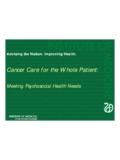Transcription of Why invest in violence 11-17-11 - World Health …
1 Why invest in violence Prevention? This document was originally prepared under Grant Agreement # for: Fetzer Institute, 9292 West KL Avenue, Kalamazoo, MI 49009 9398, by Carmen Aldinger, Julio Noguera, and Jerry Reed, Education Development Center, Inc., Health and Human Development Division, 55 Chapel Street, Newton, MA 02458, USA, with contributions from members of the World Health Organization violence Prevention Alliance Funders Connect Project Group: Alexander Butchart, World Health Organization; Nancy Cardia, Centre for the Study of violence ; Keith Cernak, Health Protec; and Peter Donnelly, University of St. Andrews. Suggested citation: violence Prevention Alliance and Education Development Center. Why invest in violence prevention? Geneva, Switzerland, and Newton USA, VPA and EDC, 2011.
2 November 2011 2 Executive Summary Scope of violence . violence affects a significant proportion of the population. It threatens the lives and physical and mental Health of millions of people, overburdens Health systems, undermines human capital formation, and slows economic and social development. Alongside the deaths it causes are the significant consequences of non fatal violence : injuries and disabilities, mental Health and behavioural consequences, reproductive Health consequences, other Health consequences, and the impact of violence on the social fabric. While violence affects people everywhere, those living in low and middle income countries are at substantially greater risk for most forms of violence , and over 90% of violent deaths occur in these countries. Preventability of violence . violence is predictable and therefore preventable.
3 The World Health Organization (WHO) has identified strategies for evidence based interventions to prevent interpersonal and self directed violence : developing safe, stable, and nurturing relationships between children and their parents and caregivers; developing life skills in children and adolescents; reducing availability and harmful use of alcohol; reducing access to guns, knives and pesticides; promoting gender equality; changing cultural norms that support violence ; and ensuring victim identification, care, and support. Most violence prevention programmes have yet to be systematically implemented and monitored for their impact in low and middle income countries where the problem is the largest and the potential prevention gains are the greatest. Why invest in violence prevention? There are several moral, public Health , societal, economic, and business reasons for investing in violence prevention.
4 Specifically, violence prevention: Supports basic human rights Reduces death and disease Addresses underlying societal factors and so intersects with other ongoing initiatives that address macro level factors Can accelerate economic development Can improve revenues What sorts of activities should be supported? WHO, CDC, and others have developed a substantial body of high quality, science based technical and normative guidance on how to better understand and prevent violence . Within this context, donor options for investment in violence prevention include: Direct prevention programming activities Surveillance and data work Research Meetings Coordination and secretariat functions Conclusion. The moral, Health , and business reasons for scaling up investments in violence prevention are compelling.
5 By reducing the inequities in prevention investments between violence and related conditions, donors can safeguard against the likelihood that Health gains achieved through their investments in disease prevention will be erased by the subsequent violent victimization of those whose lives are saved. 3 Value Proposition Statement This document has been prepared by the Funders Connect project group of the violence Prevention Alliance (VPA). The Funders' Connect group is led by staff from the Education Development Center in Massachusetts, USA, and includes VPA participants from Brazil, the UK, the USA, and the World Health Organization's headquarters in Switzerland. It aims to connect violence prevention practitioners with potential funders, and to connect donors that already fund violence prevention with one another.
6 In this way, the Funders' Connect group hopes to increase the amount and quality of funding available to public Health oriented violence prevention programmes everywhere. This document aims to make the case for increasing financial investment in the public Health approach to the prevention of violence , and by doing so to strengthen the effectiveness of prevention programming, with the ultimate goal of preventing new acts of violence and averting their consequences for individuals, families, communities and societies. We encourage readers to draw upon the text of this document when preparing your own proposals and presentations aimed at making the case for increased violence prevention funding. You may use the text in part or as a whole, but in so doing please acknowledge this document as the source (see suggested citation on the cover page).
7 Scope of violence violence represents a major Health , criminal justice, human rights, and development challenge. It threatens the lives and physical and mental Health of millions of people, overburdens Health systems, undermines human capital formation, and slows economic and social violence affects a significant proportion of the population. Globally, 1 in 5 women and up to 1 in 10 men are victims of sexual violence in The WHO Multi country Study on Women s Health and Domestic violence Against Women found that the proportion of ever partnered women who had ever experienced physical or sexual violence , or both, by an intimate partner in their lifetime, ranged from 15% to 71%, with most sites falling between 29% and 62%.3 Each year, over 16 million people receive medical treatment for a violence related For people aged 15 44 years, homicide and suicide are among the top five causes of death.
8 The annual toll of million violence related deaths is about half as many as those due to HIV/AIDS, roughly the same as those due to tuberculosis, and more than the annual number of deaths due to malaria or road traffic While violence affects 1 violence Prevention Alliance. (2010). violence Prevention Alliance: Conceptual framework (p. 1). Geneva: World Health Organization. 2 WHO ISPCAN. (2006). Preventing child maltreatment: A guide to taking action and generating evidence (p. 11). Geneva: World Health Organization. 3 Garcia Moreno, C. et al. (2005). WHO multi country study on women s Health and domestic violence against women (p. 55). Geneva: World Health Organization. 4 World Health Organization. (2008). The global burden of disease: 2004 update. Geneva: Author.
9 Retrieved from (Annual incidence (000s) for selected causes, in WHO Regions (a), estimates for 2004). 5 World Health Organization. (2008). The global burden of disease: 2004 update. Geneva: Author. Retrieved from (Summary: Deaths (000s) by cause, in WHO Regions (a), estimates for 2004) 4people everywhere, those living in low and middle income countries are at substantially greater risk for most forms of violence , and over 90% of violent deaths occur in these countries. When violence does occur in these countries, people there have extremely limited access to adequate emergency medical services, psychosocial help, and legal assistance. Most deaths due to violence occur in settings that are at peace, and most perpetrators are victims themselves or people who are close to the victim, such as parents, intimate partners, friends, and Alongside the deaths it causes are the significant consequences of non fatal violence : injuries and disabilities, mental Health and behavioural consequences, reproductive Health consequences, other Health consequences, and the impact of violence on the social fabric.
10 Together, these account for a substantial proportion of the global burden of disease, and in countries and regions where violence is highly prevalent, they erode social and intellectual capital and undermine human and economic Preventability of violence violence is predictable and therefore preventable. The World Health Organization (WHO) published in 2009 a series of briefings that reviewed the evidence for interventions to prevent interpersonal and self directed violence . The seven briefings provided guidance for the following violence prevention strategies: developing safe, stable, and nurturing relationships between children and their parents and caregivers; developing life skills in children and adolescents; reducing the availability and harmful use of alcohol; reducing access to guns, knives and pesticides; promoting gender equality to prevent violence against women; changing cultural norms that support violence ; and ensuring victim identification, care and The briefings showed how programmes that address underlying causes and risk factors can reduce the frequency of violence related outcomes by up to 50%.

















